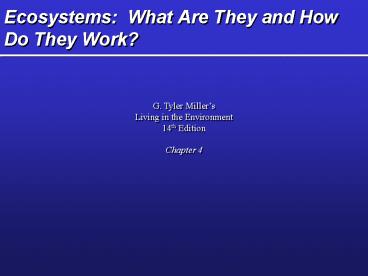Ecosystems: What Are They and How Do They Work? - PowerPoint PPT Presentation
1 / 27
Title:
Ecosystems: What Are They and How Do They Work?
Description:
Ecosystems: What Are They and How Do They Work? G. Tyler Miller s Living in the Environment 14th Edition Chapter 4 Key Concepts The Nature of Ecology The Earth s ... – PowerPoint PPT presentation
Number of Views:130
Avg rating:3.0/5.0
Title: Ecosystems: What Are They and How Do They Work?
1
Ecosystems What Are They and How Do They Work?
G. Tyler Millers Living in the Environment 14th
Edition Chapter 4
2
Key Concepts
- Basic ecological principles
- Major components of ecosystems
- Matter cycles and energy flow
- Ecosystem studies
- Principles of Sustainability
3
The Nature of Ecology
- Ecosystem organization
- Organisms
- Populations
- Communities
- Ecosystems
- Biosphere
Fig. 4-2 p. 57
4
The Earths Life-Support Systems
- Troposphere
- Stratosphere
- Hydrosphere
- Lithosphere
- Biosphere
Fig. 4-7 p. 60
5
Natural Capital Sustaining Life of Earth
- One-way flowof energy from Sun
- Cycling ofCrucial Elements
- Gravity
Fig. 4-8 p. 60
6
Solar Capital Flow of Energy to and from the
Earth
Fig. 4-9 p. 61
7
Natural Capital Major Biomes
- Biomes
- Role of climate
- Aquatic life zones
Fig. 4-10 p. 62
8
Ecosystem Factors
- Abiotic factors
- Range of tolerance
- Biotic factors
- Limiting factors
Fig. 4-13 p. 64
9
Components of Ecosystems
- Abiotic chemicals
- Photosynthesis
- Producers(autotrophs)
- Consumers(heterotrophs)
- Aerobicrespiration
- Decomposers
Fig. 4-17 p. 67
10
Biodiversity
- Genetic diversity
- Species diversity
- Ecological diversity
- Functional diversity
11
Connections Energy Flow in Ecosystems
- Food chains
- Trophic Levels
- Food webs
12
Trophic Levels
- Primary consumer (herbivore)
- Secondary consumer (carnivore)
- Tertiary consumer
- Omnivore
- Detritivores and scavengers
- Decomposers
13
Connections Food Chains and Energy Flow in
Ecosystems
Fig. 4-18 p. 68
14
Ecological Pyramids
- Pyramid ofenergy flow
Fig. 4-21 p. 70
- Ecologicalefficiency
- Pyramid ofbiomass
- Pyramid ofnumbers
15
Primary Productivity of Ecosystems
- Gross primary productivity (GPP)
- Net primary productivity (NPP)
Fig. 4-24 p. 72
16
Soils
- Origins
- Importance
- Maturity and Horizons
- Variations with Climate and Biomes
- Variations in Texture and Porosity
17
Soil Profiles in Different Biomes
Fig. 4-27, p. 75
18
Connections Matter Cycling in Ecosystems
- Biogeochemical cycles
- Hydrologic cycle (H2O)
- Carbon cycle
- Nitrogen cycle
- Phosphorus cycle
- Sulfur cycle
19
Hydrologic (Water) Cycle
Fig. 4-28 p. 76
20
The Carbon Cycle (Marine)
Fig. 4-29, p. 78
21
The Carbon Cycle (Terrestrial)
Fig. 4-29, p. 79
22
The Nitrogen Cycle
Fig. 4-31 p. 80
23
The Phosphorus Cycle
Fig. 4-33 p. 82
24
The Sulfur Cycle
Fig. 4-34 p. 83
25
How Do Ecologists Learn About Ecosystems?
- Field research
- Remote sensing
- Geographic information systems (GIS)
- Laboratory research
- Systems analysis
26
Geographic Information System (GIS)
Fig. 4-35 p. 84
27
Systems Analysis
Fig. 4-36 p. 85































